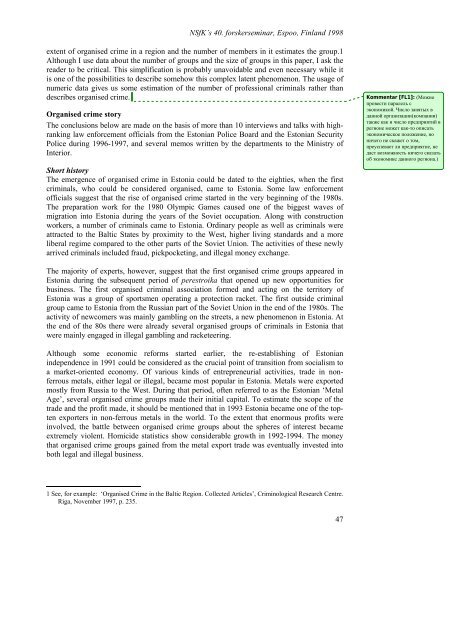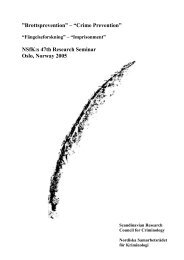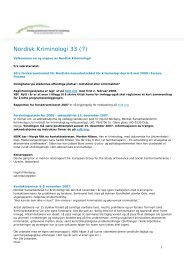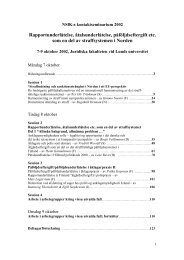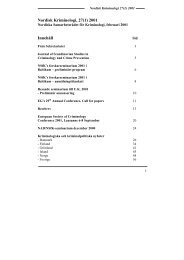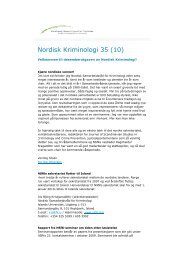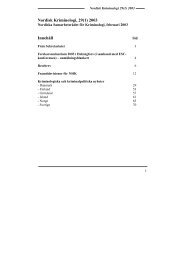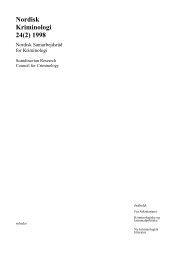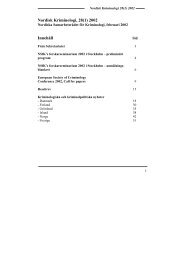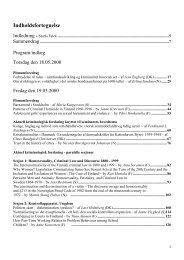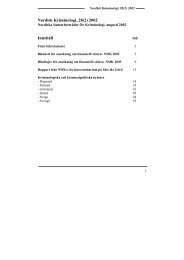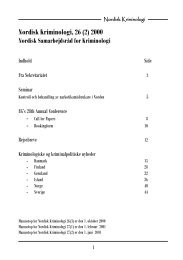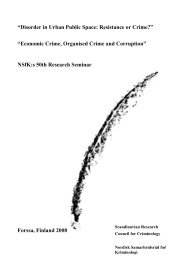Organised Crime & Crime Prevention - what works? - Scandinavian ...
Organised Crime & Crime Prevention - what works? - Scandinavian ...
Organised Crime & Crime Prevention - what works? - Scandinavian ...
You also want an ePaper? Increase the reach of your titles
YUMPU automatically turns print PDFs into web optimized ePapers that Google loves.
NSfK’s 40. forskerseminar, Espoo, Finland 1998<br />
extent of organised crime in a region and the number of members in it estimates the group.1<br />
Although I use data about the number of groups and the size of groups in this paper, I ask the<br />
reader to be critical. This simplification is probably unavoidable and even necessary while it<br />
is one of the possibilities to describe somehow this complex latent phenomenon. The usage of<br />
numeric data gives us some estimation of the number of professional criminals rather than<br />
describes organised crime.<br />
<strong>Organised</strong> crime story<br />
The conclusions below are made on the basis of more than 10 interviews and talks with highranking<br />
law enforcement officials from the Estonian Police Board and the Estonian Security<br />
Police during 1996-1997, and several memos written by the departments to the Ministry of<br />
Interior.<br />
Short history<br />
The emergence of organised crime in Estonia could be dated to the eighties, when the first<br />
criminals, who could be considered organised, came to Estonia. Some law enforcement<br />
officials suggest that the rise of organised crime started in the very beginning of the 1980s.<br />
The preparation work for the 1980 Olympic Games caused one of the biggest waves of<br />
migration into Estonia during the years of the Soviet occupation. Along with construction<br />
workers, a number of criminals came to Estonia. Ordinary people as well as criminals were<br />
attracted to the Baltic States by proximity to the West, higher living standards and a more<br />
liberal regime compared to the other parts of the Soviet Union. The activities of these newly<br />
arrived criminals included fraud, pickpocketing, and illegal money exchange.<br />
The majority of experts, however, suggest that the first organised crime groups appeared in<br />
Estonia during the subsequent period of perestroika that opened up new opportunities for<br />
business. The first organised criminal association formed and acting on the territory of<br />
Estonia was a group of sportsmen operating a protection racket. The first outside criminal<br />
group came to Estonia from the Russian part of the Soviet Union in the end of the 1980s. The<br />
activity of newcomers was mainly gambling on the streets, a new phenomenon in Estonia. At<br />
the end of the 80s there were already several organised groups of criminals in Estonia that<br />
were mainly engaged in illegal gambling and racketeering.<br />
Although some economic reforms started earlier, the re-establishing of Estonian<br />
independence in 1991 could be considered as the crucial point of transition from socialism to<br />
a market-oriented economy. Of various kinds of entrepreneurial activities, trade in nonferrous<br />
metals, either legal or illegal, became most popular in Estonia. Metals were exported<br />
mostly from Russia to the West. During that period, often referred to as the Estonian ‘Metal<br />
Age’, several organised crime groups made their initial capital. To estimate the scope of the<br />
trade and the profit made, it should be mentioned that in 1993 Estonia became one of the topten<br />
exporters in non-ferrous metals in the world. To the extent that enormous profits were<br />
involved, the battle between organised crime groups about the spheres of interest became<br />
extremely violent. Homicide statistics show considerable growth in 1992-1994. The money<br />
that organised crime groups gained from the metal export trade was eventually invested into<br />
both legal and illegal business.<br />
1 See, for example: ‘<strong>Organised</strong> <strong>Crime</strong> in the Baltic Region. Collected Articles’, Criminological Research Centre.<br />
Riga, November 1997, p. 235.<br />
47<br />
Kommentar [FL1]: (Можно<br />
провести паралель с<br />
экономикой. Число занятых в<br />
данной организации(компании)<br />
также как и число предприятий в<br />
регионе может как-то описать<br />
экономическое положение, но<br />
ничего не скажет о том,<br />
преуспевает ли предприятие, не<br />
даст возможность ничего сказать<br />
об экономике данного региона.)


